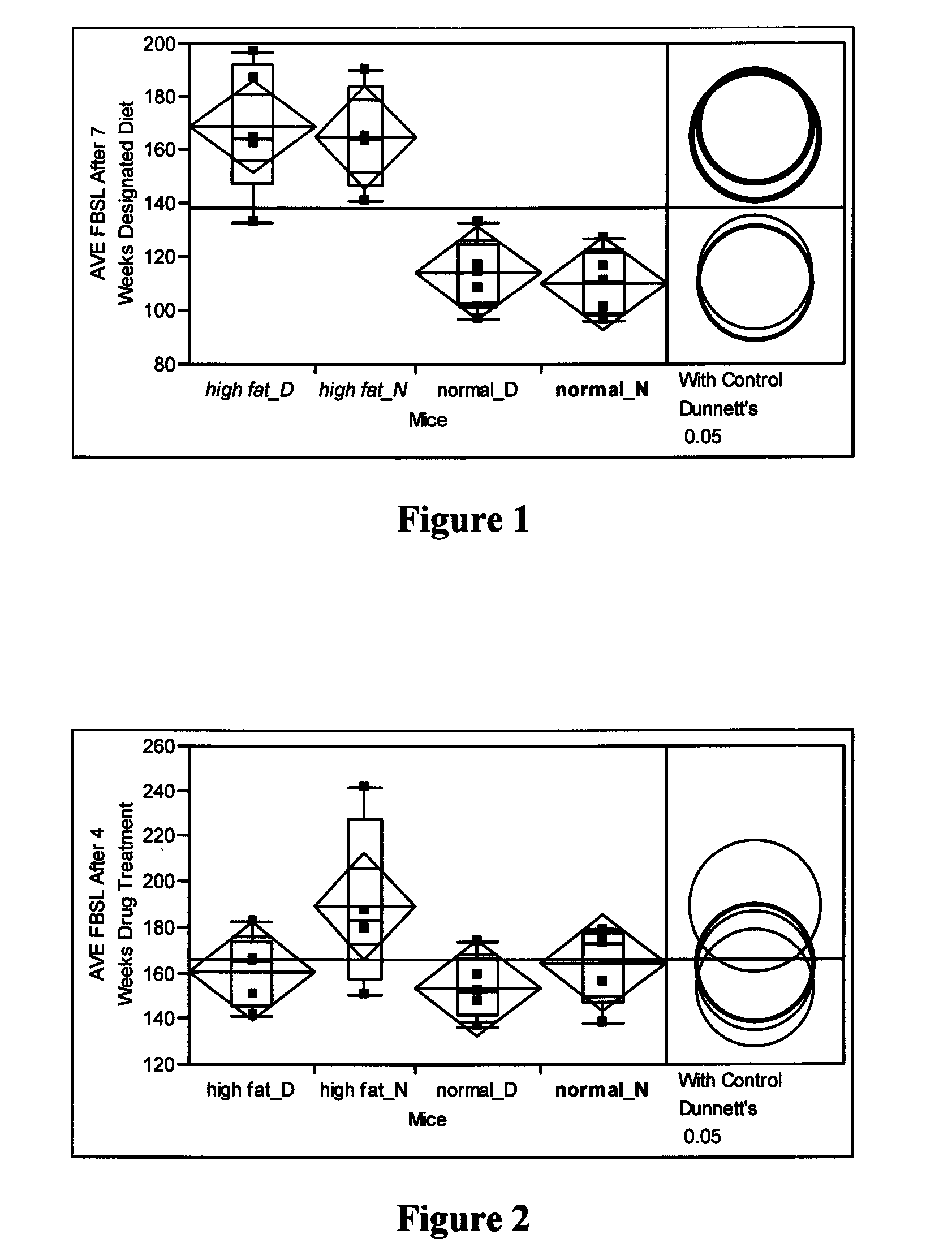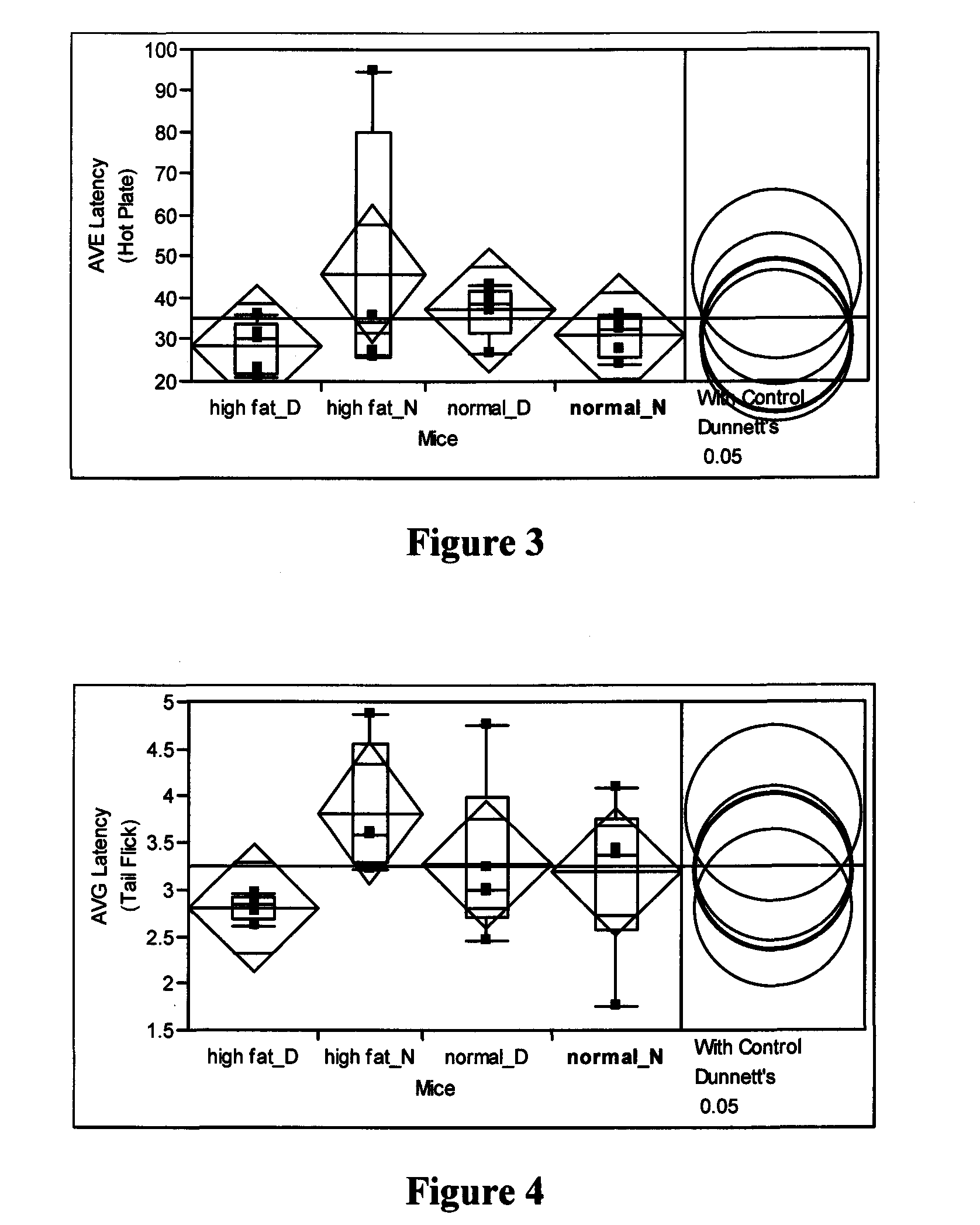Method of using dopamine reuptake inhibitors and their analogs for treating diabetes symptoms and delaying or preventing diabetes-associated pathologic conditions
a technology of dopamine reuptake inhibitors and analogs, which is applied in the direction of biocide, drug composition, metabolic disorders, etc., can solve the problems of no cure for either type i or type ii diabetes, increased mortality, and substantial morbidity, and achieve the effect of attenuating diabetic neurological manifestations and restoring sensation in the lower extremities
- Summary
- Abstract
- Description
- Claims
- Application Information
AI Technical Summary
Benefits of technology
Problems solved by technology
Method used
Image
Examples
example 1
[0084]Mediation of hyperglycemic conditions—FVB strain of mice were used in this study. In our previous study (unpublished), we noted that the FVB strain provides a broad phenotypic window for most parameters of human diabetic conditions similar to C57B1 / 6. For instance, there was a noted weight gain and obesity induced with high and intermediate fat diets. A persistent high fat diet induces relatively robust hyperglycemic conditions and inefficient glucose disposal but with little noted effects on metabolic rate. There is little circadian impact and changes in activity patterns with the high fat diet.
[0085]Twenty FVB mice (˜12 weeks of age) were randomly separated into two groups (n=10). One group (of ten mice) was fed a high fat diet (ResearchDiets, New Brunswick, N.J., and Cat. #D12492); with the following caloric components: 20 percent protein; 20 percent carbohydrate; and 60 percent fat; 5.24 kcal / gram. Another group was fed with regular rodent chow (Labdiet, Richmond, Ind., pr...
example 2
[0089]Home-cage health and behavior—This is not a qualitative measurement but the behavior pattern that we noticed during the study. All 4 groups of animals were housed in pairs or trios according to stratification of either treated with drug or vehicle. For three of the 4 groups, e.g. Normal Diet-drug-treated, Normal Diet-vehicle-treated, and high-fat-diet-drug-treated, the animals appear to be healthy, were docile to handlers and non-aggressive with each other. However the high-fat-diet-vehicle-treated group started to develop underbelly lesions, bite marks, and aggressive behavior towards littermates. This pattern of behavior became especially noticeable after overnight fasting (in order for fasting blood glucose level). In fact, after the above mentioned second examination (examination of fasting blood glucose level after 4 weeks of drug treatment), one of the mice in the high-fat-diet-vehicle-treated group had to be euthanized due to wounds and lesions. The remainders (of the f...
example 3
[0090]Mediation of diabetic-induced hypoalgesia (Hot-plate assay)—Mice were brought to the testing room and acclimatized for an hour before test. Pain reflexes in response to a thermal stimulus are measured using a Hot Plate Analgesia Meter from Harvard Apparatus. The plate surface was maintained at 48° C. that was measured by a built-in digital thermometer. Mice were placed on the hot plate which is surrounded by a clear acrylic cage with the Start / Stop trigger on the timer. Latencies to respond indicated by shaking or licking or flicking a hind paw were observed (If a mouse does not respond within 120 seconds, the test is terminated and the mouse is removed from the hot plate) and recorded. For each subject, the test was performed three times with about 30 minute rest between tests. Animals were tested one at a time and were not habituated to the apparatus prior to testing.
[0091]The results were analyzed by Wilcoxon rank-sum testing, as shown in Table 1
[0092]
TABLE 1Wilcoxon / Kruska...
PUM
| Property | Measurement | Unit |
|---|---|---|
| blood pressure | aaaaa | aaaaa |
| stress | aaaaa | aaaaa |
| time | aaaaa | aaaaa |
Abstract
Description
Claims
Application Information
 Login to View More
Login to View More - R&D
- Intellectual Property
- Life Sciences
- Materials
- Tech Scout
- Unparalleled Data Quality
- Higher Quality Content
- 60% Fewer Hallucinations
Browse by: Latest US Patents, China's latest patents, Technical Efficacy Thesaurus, Application Domain, Technology Topic, Popular Technical Reports.
© 2025 PatSnap. All rights reserved.Legal|Privacy policy|Modern Slavery Act Transparency Statement|Sitemap|About US| Contact US: help@patsnap.com



